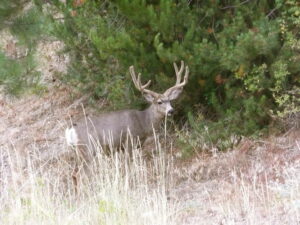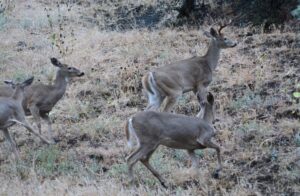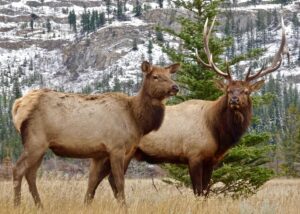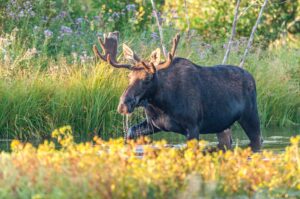Below is a news release from the Idaho Department of Fish and Game.
Fall is approaching! Once again it’s time to dust off the hunting gear, lace up, load up and head out to the hills. Hopefully before Thanksgiving most of us will have notched a tag or two and be enjoying some well-earned woodland meals shared with family and friends. Many of life’s fondest memories come from time spent in and around the pursuit of a fall’s harvest. The hunt is definitely something worth getting excited about! However, as responsible hunters we cannot let our excitement for the season be our downfall in the field.
A responsible hunter truly appreciates and understands the value of the game they pursue. One part of this respect is simply knowing the difference between the various game species and not being too hasty on the hill when the time comes to pull the trigger. Each year a handful of hunters find themselves in hot water because they didn’t brush up on their wildlife identification, they didn’t take the time to positively identify their target or didn’t pay attention to what species or sex their tag allowed them to harvest.
Over the last three years, the Southwest Region alone has seen nine incidents of moose being shot at or harvested by mistake during deer and elk seasons. In addition, many more accounts of deer and elk unlawfully harvested by mistake have been documented over the same time period.
It’s critical that hunters know what species their tags are valid for and whether they may harvest antlered or antlerless animals. Just knowing the target species is brown with antlers is not sufficient. Can you tell the difference between a mule deer and white tail deer by antlers? How about the rump of an elk vs. mule deer vs. moose? Knowing these types of specific traits will greatly benefit a hunter in the field not just by preventing a mistake, but also being able to more easily locate game hiding in cover. Once you know specifically what you’re looking for, they’re a lot easier to spot!
To make a misidentification situation worse, a large portion of mistakenly harvested animals are left to waste on the hillside. Fearing the consequences or the shame of taking the wrong animal, some hunters make another even bigger mistake and fail to report an accident. This results in multiple violations and a total loss of hundreds of pounds of valuable food which otherwise could have been salvaged and used to feed those truly in need.
Idaho Fish and Game takes care to process and donate these animals to shelters and food banks. But this can only be done if the mistake is reported immediately! Without a doubt, a hunter who turns themselves in during one of these incidents faces far less consequences than the one who chooses to walk away. While I can’t say that this has happened every time, it is true that many hunters who choose to do the right thing and take responsibility for their mistake have received warnings or minimal fines at most and no loss of hunting privileges.
So, in final preparations for the season, make sure you spend some time double checking the game tags you have in hand. What species are they for? Antlered or antlerless? Which game unit? Then take an opportunity to freshen up your wildlife identification skills. The Idaho big game regulations have pages to aid with species identification using different physical traits. There are also several great free videos and resources readily available online that make it easy. Below are some examples of common traits for moose, elk, mule deer and whitetail deer.
Lastly, if you happen to witness a possible illegal harvest or poaching event, take the time to report it. Callers may remain anonymous and still claim rewards for turning in wildlife violators! You can call your local Idaho Fish and Game office or the Citizens Against Poaching hotline at 1-800-632-5999. Save it in your phone or find it printed on the back of your hunting license. Good luck this fall!

Mule Deer Buck A mule deer buck will have antlers that fork repeatedly. Brow tines may not be present on some deer. Mule deer have white rumps with skinny all-white tails that are tipped on the end with black hair. Mule deer have relatively large ears compared to their head size.

White-Tailed Deer White-tailed deer antlers typically have one main beam that curves forward around their heads and all other points grow vertically off this main beam. Brow tines are often present. White-tailed deer have large bushy tails that are brown on the backside and white underneath. White-tailed deer have ears smaller in proportion to their heads than mule deer.

Bull and Cow Elk Mature bull elk have antlers that grow rearwards towards their backs. Young bulls may have few branches or even single points called spikes that grow almost vertically. Elk antlers are not “webbed” or “palmed” like moose antlers which are often called “paddles”. Elk can be light to medium brown and have darker brown necks and stomachs. They have lighter cream-colored rumps and small tails of the same color.

Bull Moose Moose are the largest member of the deer family, and the largest big game animal in Idaho. Both male and female moose have elongated noses similar to a horse and are almost entirely dark brown to black in color across their bodies. Male moose antlers are typically called “paddles” due to their webbed appearance like a canoe paddle. Moose may have a patch of skin/fur hanging under their chins called a “bell”.
(Photo credit: Idaho Department of Fish and Game)
